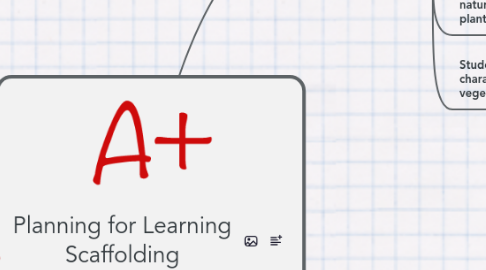
1. Goal
1.1. Standard
1.1.1. ASB SCI4c
1.1.2. Identify fruit including apples, bananas, rose apples, oranges, and pineapples.
1.2. Big Ideas
1.2.1. Student can identify different fruits, including those in the standard.
1.2.2. Student can identify different vegetables.
1.2.3. Student knows difference between fruit and vegetables.
2. Amy Harrison
2.1. Preschool
2.2. Science Unit
3. Objectives
3.1. Student can identify fruit including apples, rose apples, bananas, oranges, and pineapples.
3.1.1. Scaffolding Strategy
3.1.1.1. Visuals and Realia
3.1.1.1.1. When students are first learning fruit names the teacher will introduce new vocabulary with pictures.
3.1.1.1.2. During dramatic play students will play fruit stand to buy and sell plastic fruits.
3.1.1.1.3. Blindfold activity. Students will be blindfolded and taste test different fruits from the standard. This will help set them up for the difference between fruits and vegetables (taste).
3.1.1.2. Pre-teach Vocabulary
3.1.1.2.1. Teach students the banana song to introduce the new vocabulary word, banana.
3.1.2. Why?
3.1.2.1. The class is a mix up readiness levels. Lower ELL students will benefit by learning new vocabulary with pictures.
3.1.2.2. By asking for something when buying at the fruit stand students will need to practice new vocabulary and identifying it.
3.1.2.3. Blindfold activity is very engaging and fun for the students. Student in the class with ADHD is very attentive and has the ability to move when he moves blindfold on and off in between taste testing.
3.1.2.4. One student in the class learns best through songs. By learning the banana song he will learn and remember the new fruit word.
3.2. Student can define and describe different components of a fruit.
3.2.1. Scaffolding Strategy
3.2.1.1. Intentional Small Group/Partner Work
3.2.1.1.1. During dramatic play students will harvest fruits and vegetables. Students will have to plant different vegetable seeds and pick different fruits from trees and plants.
3.2.2. Why?
3.2.2.1. I have two girls I will pair together, because they enjoy playing together and both are enthusiastic to talk during play. One student has higher language development than the other, so my intention is she will guide play talk, but the other student will not be shy to talk back. During this center I can provide additional support and help guide conversation to observing fruits colors, size, seeds, and where it grows. Also to promote learning through dialogue.
3.3. Student can differentiate fruits and vegetables.
3.3.1. Scaffolding Strategy
3.3.1.1. Fish bowl activity
3.3.1.1.1. A small group will be in the center circled by the class modeling how it's done for the larger group. This will be the unit project. Students will have to sort different pictures of fruits and vegetables into either the fruit column or the vegetable column. The small group in the middle will take two pictures and put them in the correct column and explain why they put it in that column.
3.3.2. Why?
3.3.2.1. This will be a good opportunity for upper level ELL students to explain which fruit go in which column, and it also shows students what is expected of them. The small group will demonstrate to the larger group what the end product should look like. Some of the students in the class do not understand verbal directions, so this will serve as visual directions of what is expected.
3.4. Student can identify objects in nature including trees and plants.
3.4.1. Scaffolding Strategy
3.4.1.1. Stories
3.4.1.1.1. The teacher will read "The seasons of Arnold's Apple Tree" by Gail Gibbons.
3.4.2. Why?
3.4.2.1. Teacher will include call-backs to inspire and motivate learners. Call-backs will include new vocabulary such as tree. The students are very attentive to stories they can relate to. In this story the students can relate to the young boy and show trees that they have seen before. Also for lower ELL learners they will learn the word tree with a picture of a tree. Many of the students love listening to stories and have a big interest in story time.
3.5. Student can describe physical characteristics of fruits and vegetables.
3.5.1. Scaffolding Strategy
3.5.1.1. Show and Tell
3.5.1.1.1. At the carpet the teacher will have students sit in a circle. One at a time each student will reach into a bag and pull out a plastic fruit or vegetable. The student will tell the class what they pulled out and describe physical characteristics of the fruit or vegetable.
3.5.2. Why?
3.5.2.1. If the class is in a large group there are two students that will always answer the teachers questions first. If the teacher held up an apple and asked what color is this? The two students would answer and the rest of the class would repeat. Doing a show and tell at the carpet will allow each student the opportunity to talk and demonstrate their knowledge.
